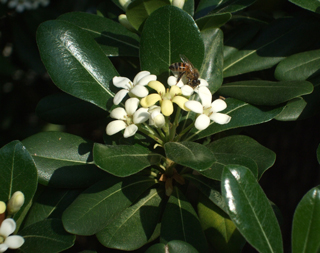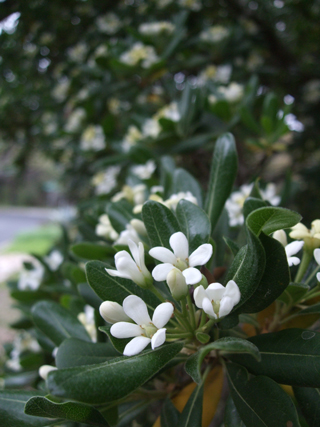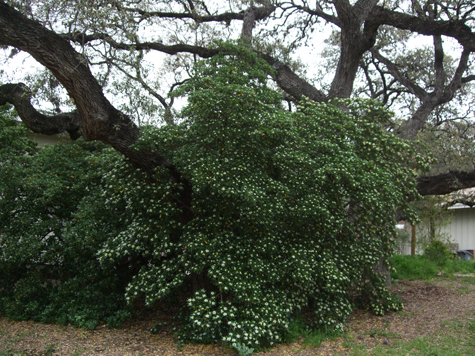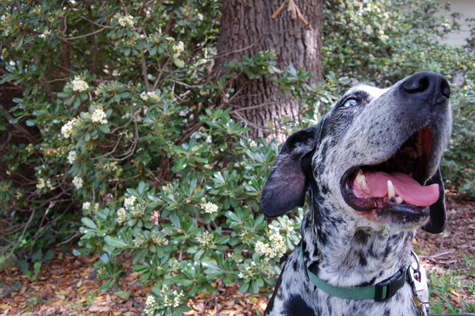Human Flower Project
Pittosporum Vindicated
After a bloomless 2011, five pittosporums more than make up for it in Austin, Texas.

A honeybee at work on the flowers of Pittosporum tobira
March 7, 2012
Photo: Human Flower Project
A rock-headed landscape specialist advised us ten years ago to chop down an old pittosporum tree. But we don’t think he’d suggest such a thing today. The huge sprawling plant —five of them actually, growing under and through a mott of live oaks in the side yard – is in full bloom. Opening the front door to get the newspaper is an ethereal act. The bees are intent but everyone else in the vicinity is spellbound— even if they don’t know why.
In last year’s drought there were no blossoms at all, a sad spring. But this year’s flowering has more than made up for it. In twelve Marches, we can’t remember a more exuberant show.
 Pittosprum tobira, Austin, Texas, 3/7/12
Pittosprum tobira, Austin, Texas, 3/7/12
in bloom after a two-year drought-induced rest
Photo: Human Flower Project
There are 200 varieties of pittosporum, natives of Australia, Southerern China and Japan. We’re fairly certain these are Pittosporum tobira, the most commonly grown in the U.S. Tobira grows high, wide, and well in many types of soil, even salty ones, according to the Clemson University site. It likes sun or part shade, too, and in our location gets a good bit of both.
The scent is lemony but sweet, reminiscent of neroli but not so cloying. Ariel Swartlet wrote a rhapsody for Los Angeles magazine several years back: “Its aroma, like that of all-spice, is an odiferous mimic—close enough to citrus that the tree is sometimes called mock prange. A careful sniffer can detect differences. Orange blossom delivers its olfactory message in Sensurround; pirttosporum is simply there, filling the night with fragrant certitude. Lacking jasmine’s back note of seraglio pittosporum’s luxurious odor is somehow cleaner, less indolent, more Big Sur than Palm Springs.”
The flowers’ color, white fading to creamy yellow, reminds us of honeysuckle. But unlike honeysuckle, pittosporum blooms are clustered in the centers of starry circles of small shining leaves. Especially when in flower, it makes a beautiful cutting for arrangements. San Antonio florist E. B. Castro told us he uses pittosporum regularly. March brides, take note.
The fact that this marvelous plant was here, well established, before we moved in makes it all the more treasured. It’s an honored resident with as strong a claim on the property as we humans pretend to hold.

Five pittosporum plants have grown underneath a mott of live oaks
Photo: Human Flower Project
The Clemson site also says, “Propagation is by semi-hardwood cuttings taken from mid July to September and treated with a root-promoting compound. Cuttings root best in a well-drained potting medium such as 50% peat and 50% perlite. Maintain high humidity around the cuttings. Generally, pittosporums are very easy to propagate.”

Gaston Miles enjoyed pittosporum season in 2007
Photo: Human Flower Project
We invite our Austin-area neighbors to come take cuttings in four months or so, and to drive by now for a scraggly slice of heaven.
Comments
Dear Annie,
Hope you will give this a try. Plus, any excuse to see you. Let’s get together before spring withers away. I’ll get in touch when the phlox flowers—soon!
J.


That expert’s urge to destruction shocked me at the time, Julie! How wise you were to let this old Austinite live and bloom where it is happy.
My part of far NW Austin is one bump colder on the zone map and pittosporum is marginal here – otherwise I’d be in line for the cuttings.
Annie at the Transplantable Rose